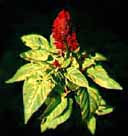Celosia
Celosia is also known as Plumosa. One variety is called Feather because it stands upright and resembles a bunch of feathers. The other is referred to as Plume or Cock's Comb due to its resemblance to a rooster's red comb. It is also nicknamed Brain-flower because it looks like a brain, only more colorful.

- This unique annual plant was brought to North America from the tropics.
- It isn't fussy about soil type and can withstand dry conditions as long as it receives plenty of sunlight.
- When planting from seeds, space them 9 to 12 inches (23 to 30 cm) apart and cover them with a little soil.
- They can reach a height of 3 feet (approximately 90 cm).
- Celosias don't require thinning.
- They don't reseed themselves, so you will have to replant them each spring from seeds or from seedlings available at most garden centers.
- These plants make excellent cut flowers for showing as the heads are very long-lasting and can be dried.
Fascinating Facts!
- Celosia is a type of flowering plant that belongs to the Amaranthaceae family. There are about 60 species of celosia.
- Celosia flowers come in many different colors, including red, pink, orange, yellow, and purple.
- The name "celosia" comes from the Greek word "kelos," which means "burned," because the flowers resemble flames.
- Celosia flowers are often used in traditional medicine to treat a variety of ailments, including fever, diarrhea, and coughs.
- Celosia plants can be grown as both annuals and perennials, depending on the species and the climate.
- Celosia flowers are a favorite of many types of butterflies, making them a great addition to butterfly gardens.
- Celosia plants are also edible! The leaves and young stems can be cooked and eaten like spinach or added to soups and stews.
more flowers
caring
|


